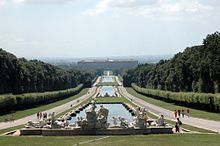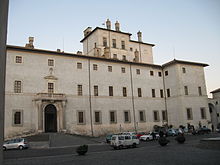- Nobility of Italy
-
 Coat of arms of the Kingdom of the Two Sicilies.
Coat of arms of the Kingdom of the Two Sicilies.
The Nobility of Italy consisted of individuals and their families of Italy recognized by sovereigns, such as the Holy Roman Emperor, the Holy See, Kings of Italy or certain other Italian kings and sovereigns as members of a class of persons officially enjoying hereditary privileges which distinguished them from other persons and families. They often held lands as fiefs and sometimes were endowed with hereditary titles. Medieval "Italy" was a set of separate states until 1870 and had many royal bloodlines. Italian royal families were often related through marriage to each other and to other European royal families.
Contents
History
Pre-unification
Prior to Italian Unification, the existence of the Kingdom of Sardinia, the Kingdom of the Two Sicilies (which before 1816 was split in Kingdom of Naples and Kingdom of Sicily), the Grand Duchy of Tuscany, the Duchy of Parma the Duchy of Modena, the Duchy of Savoy, the Duchy of Milan, the Papal States, various republics and the Austrian and French dependencies in Northern Italy led to parallel nobilities with different traditions and rules.
Kingdom of Italy (1861–1946)
Unification (1861-1870)
Modern Italy became a nation-state during the Risorgimento on March 17, 1861 when most of the states of the peninsula and Kingdom the Two Sicilies were united under king Victor Emmanuel II of the Savoy dynasty, hitherto monarch of the Kingdom of Sardinia, a realm that included Piedmont. The architect of Italian unification was Count Camillo Benso di Cavour, the Chief Minister of Victor Emmanuel. Rome itself remained for a further decade under the Papacy, and became part of the Kingdom of Italy only in 1870. In September of that year, invading Italian troops breached entered the city, and the ensuing occupation forced Pope Pius IX to his palace where he declared himself a prisoner in the Vatican until the Lateran Pacts of 1929.
Nobility in the Kingdom
Under the united Kingdom of Italy a new national nobility, with an attempt (not wholly successful) to impose a uniform nobiliary law, was created, including male succession (although it was possible for ancient titles to be transferred to an heir in the female line by royal authority), and some acknowledgement by the King of Italy of titles conferred by Francis II of the Two Sicilies in exile by making new grants in the same name. Those nobles who maintained allegiance to the pope became known as the Black Nobility.[1]
After the unification the kings of Italy continued to create titles of nobility to eminent Italians, this time with a validity for all of the Italian territory. For example, General Enrico Cialdini was created Duca di Gaeta for his role during the unification. The practice continued until the 20th century, when nominations would be made by the Prime Minister and approved by the Crown. In the aftermath of World War I most Italians who were ennobled received their titles through the Mussolini government. Examples include General Armando Diaz (Duca della Vittoria), Admiral Paolo Thaon di Revel (Duca del Mare), Commodore Luigi Rizzo (Conte di Grado e di Premuda), Costanzo Ciano (Conte di Cortellazzo i Buccari) and Cesare Maria de Vecchi (Conte di Val Cismon). Many of these were victory titles for services in World War I. The writer and aviator Gabriele d'Annunzio was created Principe di Montenevoso in 1924, and the physicst, inventor and Nobel laureate Guglielmo Marconi was ennobled also in 1924 as Marchese Marconi.
in 1929, the Lateran Treaty acknowledged all Papal titles created before that date and undertook to give automatic recognition to titles conferred by the Holy See on Italian citizens in the future.[2]
After the invasion of Abyssinia the Mussolini government recommended further Italians to the king for titles of nobility. For example, Marshal Pietro Badoglio was created Marchese del Sabotino and later Duca di Addis Abeba, and General Rodolfo Graziani became Marchese di Neghelli.
Republic of Italy
In 1946, the Kingdom of Italy was replaced by a republic. Under the Constitution of the Republic of Italy adopted in 1948, titles of nobility are not legally recognised[3].
Titles of Nobility
The official ranks under the Kingdom of Italy (1871–1946) were:
Italian Translation Masculine Feminine Masculine Feminine Re Regina King Queen Principe Principessa Prince Princess Duca Duchessa Duke Duchess Marchese Marchesa Marquess Marchioness Conte Contessa Count (Earl) Countess Visconte Viscontessa Viscount Viscountess Barone Baronessa Baron Baroness Cavaliere (Cav.) Hereditary Knight Bachelor Patrizio Patrician Nobili Nobiluomo (N.H.) Nobildonna Nobleman This hierarchy resulted from the overlapping of those set by the pre-unitarian states, which were strongly different from each other. As a consequence, titles were not homogeneously distributed throughout the country and, respectively, in each region some title was completely absent.
The southern kingdoms of Naples, Sicily and Sardinia, as well as the Papal states, granted the ranks typical of monarchies such as Spain, France or England: Prince, Duke, Marquess, Count, Baron. The title of Viscount was not as frequently in Italy.
In Northern Italy and Tuscany the situation was more complex, because there were many kinds of authorities granting titles.
Typically, Italian comunes (also in the Kingdom of Naples) and Republics granted the title of Patrician, which was only regarded as a rank of nobility in Italy.
However, the Republic of Venice also granted feudal titles. In the two Republics of Venice and Genoa, the head of state had the title of Doge, a variant form of Duca (Duke).
Until 1806, Northern Italy (except Venice) and Tuscany formed the Kingdom of Italy, belonging to the Holy Roman Empire. The Emperor retained for himself the right of creating dukes and princes. The Northern Italian monarchs had received from the Emperor the right of granting the lower feudal titles (from Marquess downwards), since these monarchs often were princes and dukes themselves.
During Renaissance the monarchs conquered all the city-republics except Venice, Genoa, Lucca, San Marino and Ragusa. So, in most of Italy, patricians were integrated into the low ranks of aristocracy.
In the Middle Ages,
“ The majority of feudatories were simply signori (from the French seigneur, a title introduced into Italy by the eleventh-century Normans), vassalli (vassals) or cavalieri (knights). Eventually, this class came to be known collectively as the baroni (barons), as in Italy barone was not always a title descriptive of a particular feudal rank. During the fourteenth century, most minor feudal lands became baronies, their holders barons. It must be observed that the use of these titles usually required some form of sovereign sanction or feudal tenure. [4] ” When in 1871 the King of Sardinia conquered the other Italian states, the Consulta Araldica (the Italian college of arms) integrated these different and varied systems in the hierarchy described above.
Papal nobility
Throughout Italy, various influential families came to positions of power through the election of a family member as Pope or were elevated into the ranks of nobility through ecclesiastic promotion. These families freely intermarried with aristocratic nobility.
Like other noble families, those with both papal power and money were able to purchase comunes or other tracts of land and elevate family patriarchs and other relatives to noble titles. Hereditary patriarchs were appointed Duke, Marquis and even Prince of various 16th and 17th century principalities.
The period was famous for papal nepotism and many families, such as the Barberini and Pamphili, benefited greatly from having a papal relative. Families that had previously been limited to agricultural or mercantile ventures found themselves, sometimes within only one or two generations, elevated to the social circles of Italian nobility when a relative was elected to the papal throne.
Modern Italy is dotted with the fruits of their success - various family palazzi remain standing today as a testament to their sometimes meteoric rise to power.
Italian Royal Palaces
- Palace of Caserta: residence of the King of the Two Sicilies.
- Royal Palace (Naples): residence of the King of the Two Sicilies.
- Museo di Capodimonte: residence of the King of the Two Sicilies.
- Palazzo dei Normanni: residence of the King of Sicily.
- Residences of the Royal House of Savoy: residences of the King of Italy.
- Palazzo Ducale di Mantova: residence of the Duke of Mantua.
- Palazzo Pitti: residence of the Grandduke of Tuscany.
- Castle of Racconigi: residence of the Carignano line of the House of Savoy.
Italian Sovereign Houses
- House of Savoy: Kings of Italy, Kings of Sardinia, Dukes of Savoy, Princes of Piedmont
- House of Este: Dukes of Ferrara, Modena and Reggio, counts of Polesine and Garfagnana
- House of Farnese: Dukes of Parma, Piacenza and Castro
- House of Bonaparte: King of Italy, King of Rome, King of Naples and Sicily, Emperor at the principality of Elba[5], Queen of Naples, Principi di Canino e di Musignano, Grand Duchess of Tuscany
- House of Bourbon: Kings of the Two Sicilies, Kings of Naples, Kings of Sicily, Dukes of Parma and Piacenza
- House of Medici: Grand Dukes of Tuscany
- House of Visconti: Dukes of Milan
- House of Sforza: Dukes of Milan
- House of Gonzaga: Dukes of Montferrat, Dukes of Mantua
Italian Papal Houses
- House of Barberini
- House of Borghese
- House of Borgia
- House of Borromeo
- House of Chigi
- House of Colonna
- House of Mattei
- House of Orsini
- House of Pamphili (later Doria-Pamphili-Landi)
`
See also
References
External links
Categories:- Italian nobility
- Lists of coats of arms
Wikimedia Foundation. 2010.



